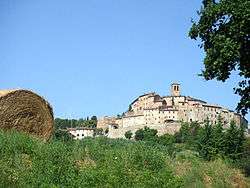Anghiari
Anghiari (Italian pronunciation: [aŋˈgjaːri]) is a hilltop town and comune in the Province of Arezzo, Tuscany, Italy.
Anghiari | |
|---|---|
| Comune di Anghiari | |
 | |
Location of Anghiari 
| |
 Anghiari Location of Anghiari in Italy  Anghiari Anghiari (Tuscany) | |
| Coordinates: 43°28′32″N 12°03′38″E | |
| Country | Italy |
| Region | Tuscany |
| Province | Arezzo (AR) |
| Frazioni | Catigliano, Motina, Ponte alla Piera, San Leo, Scheggia, Tavernelle, Viaio |
| Government | |
| • Mayor | Alessandro Polcri |
| Area | |
| • Total | 130.92 km2 (50.55 sq mi) |
| Elevation | 429 m (1,407 ft) |
| Population (30 April 2017)[2] | |
| • Total | 5,561 |
| • Density | 42/km2 (110/sq mi) |
| Demonym(s) | Anghiaresi |
| Time zone | UTC+1 (CET) |
| • Summer (DST) | UTC+2 (CEST) |
| Postal code | 52031 |
| Dialing code | 0575 |
| Saint day | May 3 |
| Website | Official website |
Bordering comuni include Arezzo (southwest), Pieve Santo Stefano (north) and Subbiano (west).
History
Anghiari is the location of the Battle of Anghiari between the Republic of Florence and the Duchy of Milan, which took place here on 29 June 1440.[3] The battle inspired a fresco in the Palazzo Vecchio by Leonardo da Vinci. The fresco has since gone missing although a sketch of it by Peter Paul Rubens is still in existence.
During World War II it hosted the concentration camp of Renicci.
Main sights
- Palazzo Pretoriano
- Badia di San Bartolomeo
- Villa La Barbolana
- Castello di Galbino
Culture
Each July, Anghiari is host to the Anghiari Festival featuring classical music, chamber music, choral works and opera. The resident orchestra is Southbank Sinfonia of London, conducted by Simon Over.
References
- "Superficie di Comuni Province e Regioni italiane al 9 ottobre 2011". Istat. Retrieved 16 March 2019.
- "Popolazione Residente al 1° Gennaio 2018". Istat. Retrieved 16 March 2019.
- Baynes, Thomas Spencer, ed. (1878). "Anghiari". Encyclopædia Britannica (Ninth ed.). New York: Charles Scribner's Sons. II: 29. Retrieved 18 June 2019 – via Wikisource.org.